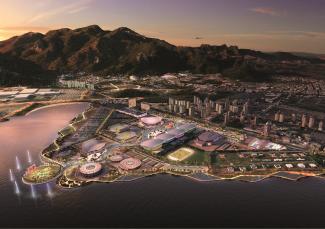


Mobility: From the car to the bike
In 2011, with the last update of the online Mapping Brazil, São Paulo was increasing the number of lanes of its Marginal Tietê expressway, which runs along the Tietê River, cutting across the city. On average, three lanes have been added in each direction, totalling 46 kilometres of roadworks costing 1.8 billion reais (around 520 million euros). Today, the city’s residents are discussing – not without a good deal of controversy – the creation of exclusive lanes for buses and bicycles. The idea is to create 150 kilometres of bus lanes and 400 kilometres of cycle paths and cycle lanes.
Public debate about investments in public transport, however muted it may be, is also on the rise, but many people’s aversion to public transport is still a major obstacle. The car still has great social value in Brazil, and is seen as an important status symbol.
São Paulo’s underground system is growing at a snail’s pace, reflecting the trend in most cities in the country. Line 4 (yellow line), under construction, is operated and maintained by Via Quatro under the country’s first ever public-private partnership contract, which involves companies from Brazil, Japan, Argentina and France. Lines that link the outskirts of the city and monorails (elevated train system) were planned to be delivered by the 2014 World Cup. The new forecast for completion is 2017.
The bicycle has been included in urban mobility plans for other cities in Brazil, like Santos and Sorocaba, both in the state of São Paulo, which now have 30 kilometres and 116 kilometres of cycle lanes, respectively.
The local authority in Rio de Janeiro intends to create 450 kilometres of cycle paths. One of the new routes, Ciclo Rotas, was devised jointly by ITDP Brazil (Institute for Transportation and Development Policy), Studio-X and Transporte Ativo, which mapped out demand for a cycle network in the centre of Rio de Janeiro using a participative methodology that included talking to cyclists and individuals keen to see the city’s cycle infrastructure expand. The study was conducted independently and submitted to the city hall, then included in the new official mobility plan. The three organisations are currently designing a collaborative app for the creation of new cycle routes.
Private banks like Itaú have sponsored bike-share systems in São Paulo, Rio de Janeiro, Belo Horizonte, Recife, Salvador, Porto Alegre and Brasilia. Cycling advocacy groups have gained ground in the country’s biggest cities: in March 2015 they closed Avenida Paulista in the centre of São Paulo to protest against the decision to stop building cycleways in the city.
Overpass in São Paulo: Demolish or turn into a park?
Elevado Costa e Silva – better known as Minhocão (literally “big worm”) – is São Paulo’s version of Rio’s Perimetral, but in São Paulo, this overpass cuts right through the highly built-up city centre. (Some residential buildings have windows that are less than five metres from the road.) The question on everyone’s lips now is: demolish it or repurpose it as a park?
The only decision taken so far is that this 2.8 kilometre overpass will definitely cease to be used as a road. The strategic master plan from 2014, which lays down the development guidelines for the city for the coming 16 years, already guarantees this. The plan requires a law to be passed to gradually restrict car access to the road until it is completely shut off to traffic. When this happens, it should either be demolished or part or all of it should be turned into a park.
There are valid arguments on both sides. Today, the overpass is shut to traffic on Sundays, when it is taken over by all manner of social events, festivities, open-air markets and sporting activities. One of the key voices in the discussion is an NGO, Association of the Friends of Minhocão Park. Its members, all people who live nearby, are keen to turn it into a municipal park that would be open to cyclists as well as pedestrians.
City for people: Jan Gehl consultancy
In a bid to revitalise the historical buildings and vicinity in the centre of São Paulo, which, like most Brazilian cities, is crowded by day but deserted by night – a place where people work and travel through but with few attractions of its own – the city council contracted Danish urbanist Jan Gehl in 2013 to do some consultancy work.
The participation of Gehl Architects was sponsored by Banco Itaú, and the findings were offered as a donation to the local authority and accepted after due analysis. The Danish architecture firm drew up a research methodology, which it rolled out in workshops, while also proposing different ways of revitalising the public spaces in the centre of São Paulo. Jan Gehl led the process, which was truly collaborative, involving people who actually use the city centre, local authority representatives and Brazilian draftspersons.
Two strategic interventions were selected in 2014 as 1:1 prototypes, whose designs were drawn up by Brazilian architectural firm Metro Arquitetos based on the outcome of Jan Gehl’s consultancy and the participative development process. As a result, two new squares have been revitalised – Largo de São Francisco and Largo do Paissandu – with children’s play areas, stands, an open-air cinema and basic infrastructure facilities.
Rio de Janeiro: Dock area and Olympic Games
The Rio landscape has undergone some major changes in recent years, mostly because of the international events the city is hosting: the World Cup in 2014 and the Olympics in 2016.
When the plans to prepare for the Olympics got underway, much was discussed about which part of the city should receive the bulk of the investments. One proposal was to build a new complex from scratch in the district of Barra da Tijuca, far from the city centre, whose development, it was argued, would benefit the city. This turned out the winner, and as a result an area covering 250,000 m2 is under development with a mixture of sports facilities and residential buildings, which will be sold off after the Games as upper-middle-class housing.
Other public competitions to develop different spaces in the city have also been held in this pre-Olympic period. The master plan for the Olympic Park was won by a multinational, Aecom. Hector Vigliecca won the competition for the Deodoro Sports Complex, covering a million square metres, where the equestrian events, hockey, shooting, fencing, modern pentathlon, mountain biking, BMX and slalom canoeing competitions will be held. Rua Arquitetos won the competition for the Olympic golf course. These developments include a number of important buildings, which have been erected without any public competition for architectural designs.
The plans to revitalise the dock area in the centre of the city, renamed Porto Maravilha, are progressing slowly. A competition to choose the best urban design, held in 2011, was won by João Pedro Backheuser (Blac), but there are as yet no signs of its execution. However, new buildings are starting to be erected in the area and new transport options are being introduced. Near where the Perimetral overpass used to be is Museu de Arte do Rio (MAR), designed by Brazilian firm Bernandes + Jacobsen, which holds art exhibitions about the city. Also planned for the Porto Maravilha area is Museu do Amanhã, set to open in 2015, designed by Spaniard Santiago Calatrava.
Continue reading Mapping Brazil - Architecture: Architecture and the City